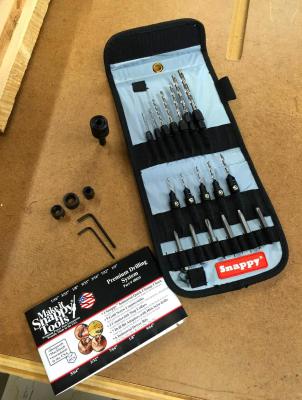Reviews
Primary tabs
These are reviews of books, movies, restaurants, local businesses, tools, and other product that I've written over the years.
Review: 'Careless' by Richard Shindell
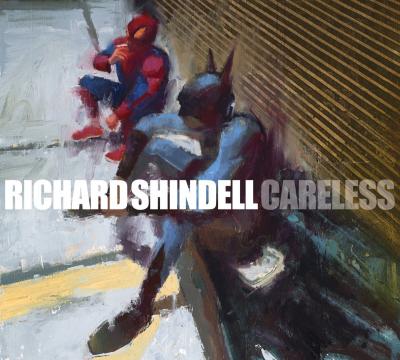 Review of “Careless” by Richard Shindell. Originally reviewed on September 26th, 2016.
Review of “Careless” by Richard Shindell. Originally reviewed on September 26th, 2016.
I'm continually appalled that Richard Shindell doesn't have a bigger following than he does, even though he resides in a genre that is perhaps not at the forefront of popularity these days, the folk singer/songwriter. Even given his street address on the margins of the musical industry, his music should be a Mecca to which true lovers of the well-crafted and poignant folk song should trek. I've been fans of other less popular artists before, and often they disappoint as their lack of monetary success wears on them artistically. Richard Shindell has had ups and downs in his output, but Careless is among the best music he has ever created. He continues to create amazing music. I bought the album after hearing a Folkways recording of one of its tracks, The Deer on the Parkway. It took a couple of listenings, but it's now firmly among my top 2 or 3 of his albums.
Review: CAGLumber - Gainesville, Georgia
 I realized last month that I'm short of material for both of my current active projects. I need several long thin pieces of quarter-sawn sycamore for the jewelry cabinet project, to build the doors. And I need a thick, wide piece of maple to fashion the leg vice for the workbench project. Since moving to Georgia, I haven't needed to buy any lumber. So, aside from the usual suspects in the retail woodworking stores, and their lumber selection is sparse, and expensive, I didn't really know where to go. The trick, you see, is the sycamore. Most lumber stores, even the full, professionally stocked ones, often don't carry sycamore. It's not a terribly popular wood, even among woodworkers. After a hunt at Woodfinder, I located exactly one lumber store within a hundred miles that claims to stock sycamore. CAGLumber is about 70 miles outside the Northeast perimeter of Atlanta, up on the other side of Gainesville, GA. I have no affiliation with this business, and no other knowledge about them, aside from the experience I'm about to convey.
I realized last month that I'm short of material for both of my current active projects. I need several long thin pieces of quarter-sawn sycamore for the jewelry cabinet project, to build the doors. And I need a thick, wide piece of maple to fashion the leg vice for the workbench project. Since moving to Georgia, I haven't needed to buy any lumber. So, aside from the usual suspects in the retail woodworking stores, and their lumber selection is sparse, and expensive, I didn't really know where to go. The trick, you see, is the sycamore. Most lumber stores, even the full, professionally stocked ones, often don't carry sycamore. It's not a terribly popular wood, even among woodworkers. After a hunt at Woodfinder, I located exactly one lumber store within a hundred miles that claims to stock sycamore. CAGLumber is about 70 miles outside the Northeast perimeter of Atlanta, up on the other side of Gainesville, GA. I have no affiliation with this business, and no other knowledge about them, aside from the experience I'm about to convey.
 Their website made them look like a small, Mom and Pop type of operation, but they did list quarter-sawn sycamore as something they have in stock. The other part of this that was important was that it looks like the website had been updated within the last few months. That's not always the case with small lumber suppliers, and you never know until you call if they're still in business. The site listed their hours as weekday only, but they did mention that they will open on Saturdays if you call ahead. I called and spoke to a very helpful gentleman, and his attitude was basically, 'Sure, I can be here on Saturday. I live in my house right here and if you call me right before you come over, I can walk over to the shop.' And he assured me they did in fact have a nice selection of quarter-sawn sycamore in stock and some very nice thick pieces of maple. I said Thank you, and planned a trip for that Saturday.
Their website made them look like a small, Mom and Pop type of operation, but they did list quarter-sawn sycamore as something they have in stock. The other part of this that was important was that it looks like the website had been updated within the last few months. That's not always the case with small lumber suppliers, and you never know until you call if they're still in business. The site listed their hours as weekday only, but they did mention that they will open on Saturdays if you call ahead. I called and spoke to a very helpful gentleman, and his attitude was basically, 'Sure, I can be here on Saturday. I live in my house right here and if you call me right before you come over, I can walk over to the shop.' And he assured me they did in fact have a nice selection of quarter-sawn sycamore in stock and some very nice thick pieces of maple. I said Thank you, and planned a trip for that Saturday.
Christmas Gift - Lie-Nielsen Rabbet Block Plane with Nicker
Adriana got me one woodworking gift for Christmas this year, but it was a really good and useful one. I had been asking for a hand plane that I could use in corners. She splurged and got me the specific one I had hoped for, a Lie-Nielsen Rabbet Block Plane with Nicker, Number 1-60-1-2R-N. Boy, what a mouthful. But it's a beauty, and for the price, it works just as you would expect. I did touch up the sharpness out of the box, but I really didn't need to.
 It's a gorgeous tool and along with my two other LN hand planes, will no doubt last my lifetime and probably those of my sons. Here, some tool pron. . .
It's a gorgeous tool and along with my two other LN hand planes, will no doubt last my lifetime and probably those of my sons. Here, some tool pron. . .
As with all of Lie-Nielsen tools, they're traditionalists. Unlike Lee Valley, they don't seem to feel the need to improve on the classics. It's got an impressive heft, and it's wicked sharp. The blade is a custom shape with flanges on each side to extend out into the rabbet corners at each edge. The nickers are round blades screwed into each side of the blade. As shipped, they come with a flattened section facing down so you're not apt to cut yourself when first handling it. One of the only criticisms I could really come up with for this tool is that it is a bit tricky to loosen the screw and tighten it down in a way that the sharp edge is down.
Review: Snappy 25 Piece Countersink and Hex Drill Bit Set
One of my wife's Christmas gifts to me this year was this Snappy 25 Piece drill bit set. Originally, I had put the Rockler 10 piece (approximately) countersink set on an Amazon wish list, but when she talked to the local Rockler, they were amazed at the price listed on my wish list, which had been something like $30, and they said they were all sold out, "Not surprising, really, at that price." And Rockler didn't have anything that matched that in stock, so she went to the Alpharetta WoodCraft. They pointed her to the Snappy set.
Woodcraft lists this set on their website at $80. It is 100% American made and assembled, and my wife knows I am willing to pay a premium to support American manufacturers, so she got it. She tells me she got a much better price than that in the week before Christmas. With only a couple of fairly minor nitpics, I really like this set and decided I should formally review it so others might decide to get it as well. I feel it is worth the money.
What you get -- In the plastic packaging, you get a set of five counter-sink drill bits in the standard American sizes, two countersink stop collars, seven drill bits in 1/4" hex shank adapters, six driver bits, a couple of allen wrenches, a nylon carrying case, and best of all a Snappy 1/4" hex quick change chuck. Overall, the set seems to be machined very well. All of the pieces have a good heft to them, especially the chuck.
Book Review: Exploring Arduino by Jeremy Blum
Review of “Exploring Arduino: Tools and Techniques for Engineering Wizardry” by Jeremy Blum. Reviewed on August 24th, 2015.
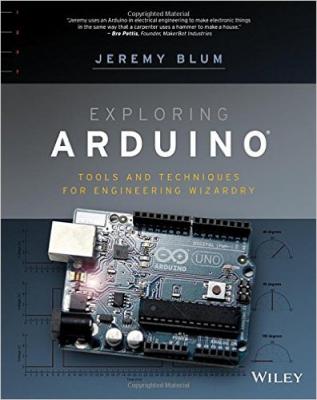 I’m coming to review this book rather late. It was published in late 2013, I believe, but I’ve only recently purchased it and wanted to pipe up with my two cents’ worth. As many people can probably say, I originally encountered the works of Jeremy Blum on YouTube. I bought my first Arduino board in late 2013. Being a busy professional and father, I didn’t have a whole lot of time to play around with it, although I truly did want to play. But I can’t really learn new things in a vacuum, so I quickly developed a project to use my first board on: a timing track for my son’s Boxwood Derby car. (He had a brief interest in the Cub Scouts, which has long since waned.) So searching the Intertubes for training materials on the Arduino was natural. I looked at many of them, but by far the best at least in my opinion, were the short videos produced on the topic by Jeremy Blum with the support of the electronics supply company Element 14. (Note: I have no association with the author or any of the companies mentioned here.)
I’m coming to review this book rather late. It was published in late 2013, I believe, but I’ve only recently purchased it and wanted to pipe up with my two cents’ worth. As many people can probably say, I originally encountered the works of Jeremy Blum on YouTube. I bought my first Arduino board in late 2013. Being a busy professional and father, I didn’t have a whole lot of time to play around with it, although I truly did want to play. But I can’t really learn new things in a vacuum, so I quickly developed a project to use my first board on: a timing track for my son’s Boxwood Derby car. (He had a brief interest in the Cub Scouts, which has long since waned.) So searching the Intertubes for training materials on the Arduino was natural. I looked at many of them, but by far the best at least in my opinion, were the short videos produced on the topic by Jeremy Blum with the support of the electronics supply company Element 14. (Note: I have no association with the author or any of the companies mentioned here.)
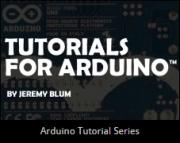 I used those Arduino Tutorial videos to bring myself up to speed quickly. I actually managed to get a timing circuit built in time for my son to enter his car in an elementary school science fair. True, we only re-proved what Galileo figured out in 1638, but still, it’s always nice to see that the laws of physics haven’t changed. I was very grateful to Mr. Blum for his guidance. At the time, I remember being astonished that such clear, cleanly explained training films existed for the Arduino and that they had been created by an undergraduate engineering student! When he announced that he was writing a book, I sort of felt like I owed it to him to buy and read it. (Plus, he had helped to get me hooked on this whole open-source hardware maker movement, so I was naturally curious to learn more.)
I used those Arduino Tutorial videos to bring myself up to speed quickly. I actually managed to get a timing circuit built in time for my son to enter his car in an elementary school science fair. True, we only re-proved what Galileo figured out in 1638, but still, it’s always nice to see that the laws of physics haven’t changed. I was very grateful to Mr. Blum for his guidance. At the time, I remember being astonished that such clear, cleanly explained training films existed for the Arduino and that they had been created by an undergraduate engineering student! When he announced that he was writing a book, I sort of felt like I owed it to him to buy and read it. (Plus, he had helped to get me hooked on this whole open-source hardware maker movement, so I was naturally curious to learn more.)
To summarize my perspective on the book, I’m a working IT professional who had introductory practical electronics courses as a Physics student nearly 30 years ago, so many of the concepts here aren’t new to me. I’ve played around with small circuits on my own for many years, but I was never really a hobbyist, more of a dabbler. But with the arrival of the Arduino and the Raspbery Pi, I finally had the opportunity to try out working with microcontrollers. I had always been a bit too busy and perhaps slightly intimidated to take that particular plunge. I think maybe that’s Jeremy’s best trait, he makes you unafraid to try out new things. The other thing I should mention here is that I've worked as a technical writer for many years, so I'm aware of the technical aspects of putting together this kind of hardware/software instructional book. It's a unique kind of challenge to write about both technical hardware and software in a combined work.
So, the book . . . I bought the paperback on Amazon during a month in which Mr. Blum turned out to be donating his profits to young, women engineers. I can certainly get behind that cause and I’m glad it worked out that way. The book, printed by Wiley is nicely printed. I like the texture and design of the cover. The pages are fairly standard for technology/programming books, black and white on a medium-light weight, matte stock. The layout of chapters are clean and crisp; the typography clear and legible and the illustrations printed well in greyscale. The illustrations are basically an even mixture of screen grabs of the Arduino IDE interface, what looks to be Mac OS X operating system windows and elements, circuit diagrams done in Fritzing, a few photos likely taken by the author, and a few black and white diagrams of key concepts.
The structure follows the YouTube tutorial videos pretty closely, introducing elementary engineering principles first and then moving on to the basics of how a microcontroller works, the practical capabilities of an Arduino, and then simple and more complex projects created with one. Usually, the author sticks with the Arduino Uno, but he does acknowledge and occasionally even suggest projects for the other models. He starts each chapter calling out the digital resources available related to the material in the chapter, which is nice. He naturally links back to his tutorial videos, but he isn’t shy pointing to other valuable online resources. All of the sketches, diagrams and schematic files he uses are available on a custom website supporting the book. (www.exploringarduino.com)
2013 - The Good and the Bad
 Personally, 2013 wasn't that bad, particularly compared to the Hell that were 2011 and 2012. But from a more global and holistic perspective, 2013 was one heck of a rocky ride. Just in an effort to capture some of my thoughts about what just happened to us all, I thought I'd try to capture my view of what was particularly good and particularly sucky about the 13th year of this latest millennium. I think I'll talk about many of these things in more detail in other posts, so I'm just going to skim the topics.
Personally, 2013 wasn't that bad, particularly compared to the Hell that were 2011 and 2012. But from a more global and holistic perspective, 2013 was one heck of a rocky ride. Just in an effort to capture some of my thoughts about what just happened to us all, I thought I'd try to capture my view of what was particularly good and particularly sucky about the 13th year of this latest millennium. I think I'll talk about many of these things in more detail in other posts, so I'm just going to skim the topics.
Do you want the good or the bad first?
Okey-dokey.
Swedish Brandy Rings
 I'm half Slovak, and proud of it. My mother was from a small village along the Ukrainian border, arriving in the U.S. at age 6. I mention this because the tradition of baking for Christmas that epitomizes Slovak wintertime is the context into which I was presented this particular recipe. Given the name, I'm sure that my mother's Swedish Brandy Rings were not something the family brought with them on the U.S.S. Paris in 1937. But I think of it as one of her Slovak Christmas cookies. We made it every year for at least 40 years, and I continue the tradition. My wife absolutely loves these, and demands them every December.
I'm half Slovak, and proud of it. My mother was from a small village along the Ukrainian border, arriving in the U.S. at age 6. I mention this because the tradition of baking for Christmas that epitomizes Slovak wintertime is the context into which I was presented this particular recipe. Given the name, I'm sure that my mother's Swedish Brandy Rings were not something the family brought with them on the U.S.S. Paris in 1937. But I think of it as one of her Slovak Christmas cookies. We made it every year for at least 40 years, and I continue the tradition. My wife absolutely loves these, and demands them every December.
The recipe is a simple butter cookie that is perfect for accompanying coffee or tea. Unlike other liquor-infused cookies for the holidays, it has only enough alcohol to provide flavor. It's not intended to give a kick, which is good, since I ate a bunch of these as a kid.
Cool Video Series about Wine on Le Creuset website
 I just noticed today that Le Creuset has a very nice wine video series started on their website. For those of you who don't know, Le Creuset is a French company (obviously) that makes these gorgeous enameled cast iron cook pieces. I also like to cook, and I have the same stupid weakness for expensive tools in that avocation as I do in woodworking. Le Creuset pieces are not cheap, which is why we currently only own one, a very nice red skillet I found in a factory outlet store in Ellenton, Florida about three years ago. Currently, I'm lusting after one of their Dutch ovens, but at a list price of more than $250, that one will have to wait. (It's funny to note that they don't actually call their Dutch oven a Dutch oven. In typical Franco-centric fashion, they call them French ovens.) Or perhaps a nice, large cocotte. A Le Creuset store is as dangerous for me as is a Lie-Nielsen road show.
I just noticed today that Le Creuset has a very nice wine video series started on their website. For those of you who don't know, Le Creuset is a French company (obviously) that makes these gorgeous enameled cast iron cook pieces. I also like to cook, and I have the same stupid weakness for expensive tools in that avocation as I do in woodworking. Le Creuset pieces are not cheap, which is why we currently only own one, a very nice red skillet I found in a factory outlet store in Ellenton, Florida about three years ago. Currently, I'm lusting after one of their Dutch ovens, but at a list price of more than $250, that one will have to wait. (It's funny to note that they don't actually call their Dutch oven a Dutch oven. In typical Franco-centric fashion, they call them French ovens.) Or perhaps a nice, large cocotte. A Le Creuset store is as dangerous for me as is a Lie-Nielsen road show.
Book Review: Timber Frame Construction by Jack Sobon and Roger Schroeder
Review of "Timber Frame Construction: All About Post-and-Beam Building" by Jack Sobon and Roger Schroeder. Reviewed on October 15th, 2013.
 Most of the woodworking projects I've taken on over the years have been small projects or pieces of furniture, but I've also had a habit of building in a pseudo-beam construction manner. Growing up on an Ohio farm, we always had a few extra beams or pieces of construction lumber around, and I would sometimes build little contraptions using screws and nails and other found hardware. Aside from a grandfather clock I built at 17 from a kit, my first real piece of self-designed 'furniture' was a loft for my bedroom, built the summer before I left for college. And it was not a thing of beauty. I wanted a way to put my bed up high with a desk underneath to increase the usable space in my bedroom. Such things are common these days, but in the 1980s, they were still fairly rare. Anyway, I built it simply by buying Home Depot lumber, some constuction grade, other pressure-treated landscaping timbers. I didn't really know the difference then. And I built what could be charitably described as a post and beam loft. It even had little notches cut out of the 4x4 posts to accept the bed frame. I didn't know a lick about joints, so I didn't realize I was making half laps. But . . . it worked.
Most of the woodworking projects I've taken on over the years have been small projects or pieces of furniture, but I've also had a habit of building in a pseudo-beam construction manner. Growing up on an Ohio farm, we always had a few extra beams or pieces of construction lumber around, and I would sometimes build little contraptions using screws and nails and other found hardware. Aside from a grandfather clock I built at 17 from a kit, my first real piece of self-designed 'furniture' was a loft for my bedroom, built the summer before I left for college. And it was not a thing of beauty. I wanted a way to put my bed up high with a desk underneath to increase the usable space in my bedroom. Such things are common these days, but in the 1980s, they were still fairly rare. Anyway, I built it simply by buying Home Depot lumber, some constuction grade, other pressure-treated landscaping timbers. I didn't really know the difference then. And I built what could be charitably described as a post and beam loft. It even had little notches cut out of the 4x4 posts to accept the bed frame. I didn't know a lick about joints, so I didn't realize I was making half laps. But . . . it worked.
While I was working on it in the garage, and had the thing roughly put together with bolts and a few screws, my Dad's construction handyman saw it and said, ' You know, not bad.' He was being kind. It was strong enough for me to sleep on it, but it had a tendency to rack. I used it for a few months before leaving for college, and when I came home for holidays for the next couple years. Eventually, it got broken up and used in other projects . . . mostly landscaping stuff around the farm.
The point of this little tale? I have a hankerin' for some traditional timber frame structures.
Design Influence - Patterns of Home
 I've started reading "By Hand & Eye", the new book on furniture design by George Walker and Jim Tolpin, but I've not gotten more than a quarter of the way through it so far. When I finish it, I'll write up my reactions. But for now, my reaction is "Yes, I get it, proportions are important and you don't need a ruler."
I've started reading "By Hand & Eye", the new book on furniture design by George Walker and Jim Tolpin, but I've not gotten more than a quarter of the way through it so far. When I finish it, I'll write up my reactions. But for now, my reaction is "Yes, I get it, proportions are important and you don't need a ruler."
I've been thinking about the multi-faceted aspects of design lately, particularly as it pertains to architecture and object creation (i.e. furniture or small woodworking projects.) I've realized more and more in recent months that most of my perspective on what is good design and what isn't is related to a book that I bought and read about 10 years ago. It's called "Patterns of Home: The Ten Essentials of Enduring Design" and it's terrific. The ideas in that book have completely stuck with me and have deeply influenced many areas of creativity in my life.
So what is this book? "Patterns of Home: The Ten Essentials of Enduring Design" is by Max Jacobson, Murray Silverstein and Barbara Winslow, and is a condensed version of a much larger work from the 70s, a gigantic book called "A Pattern Language: Towns, Buildings, Construction". That earlier book, first published in 1977, is over a thousand pages in length and is legendary in the architecture world. I've never read the older book. I've only been exposed to the ideas through this later, more graphical Patterns of Home book.
Book review: Radical Abundance by K. Eric Drexler
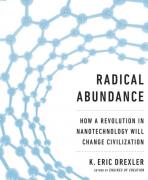 Review of "Radical Abundance: How a Revolution in Nanotechnology will Change Civilization" by K. Eric Drexler. Reviewed on July 8th, 2013.
Review of "Radical Abundance: How a Revolution in Nanotechnology will Change Civilization" by K. Eric Drexler. Reviewed on July 8th, 2013.
Back in the 1980s, Eric Drexler coined the term and popularized the concept of what we now call 'nanotechnology'. This book is a sort of 'So where are we now?' update on the state of the art and the concepts. I found the book alternatingly mind-blowing and tedious. That's somewhat hard to do, yet that was my experience with Radical Abundance.
I think the reason for that reaction is that the author's intent in writing this books is somewhat schyzophrenic. He wants to popularize his ideas, but he saw what happened to them back in the 90s and early 2000s, and is afraid that that will happen again. He sees in the history of this technology that it went wildly awry from his intentions, but for political reasons dealing with human nature rather than anything technical. He wants us to be excited, but not overly excited. That latter part is where the tedium comes in. He attempts to undermine the 'gee-whiz' aspects of the ideas as much as he can, because he doesn't want accolytes. He wants thinking engineers to make it come true. But this dual focus can cause him to be a bit repetitive and a bit of a worrywart.
Restaurant review: The Mill Kitchen and Bar, Roswell, Georgia
Review of The Mill Kitchen and Bar in Roswell, Georgia, 6/8/2013 --
 My wife and I went out for one of our all-to-infrequent nights out without the kids. We were hoping for a nice romantic meal with some good food and quiet conversation. The Mill turned out to be perfect. The atmosphere was good for conversation and they have a wonderful area outside to sit. We opted for the inside dining room since we wanted to talk and the guitarist playing outside wasn't loud, but since we were escaping the kids, we opted for quiet. The inside is decorated well and, aside from a slightly strong smell of fried fish when we first entered, was wonderful. We ordered the cheese vegetable and meat selection as an appetizer. This was clearly local food and very unique. The Georgia prosciutto was fresh and flavorful and I liked the sweet/dill baby pickles and very fresh olives. My wife loved the slightly pickled okra slices and I loved the sliced figs. This was accompanied by a sliced bread which was crumbly but not terribly flavorful.
My wife and I went out for one of our all-to-infrequent nights out without the kids. We were hoping for a nice romantic meal with some good food and quiet conversation. The Mill turned out to be perfect. The atmosphere was good for conversation and they have a wonderful area outside to sit. We opted for the inside dining room since we wanted to talk and the guitarist playing outside wasn't loud, but since we were escaping the kids, we opted for quiet. The inside is decorated well and, aside from a slightly strong smell of fried fish when we first entered, was wonderful. We ordered the cheese vegetable and meat selection as an appetizer. This was clearly local food and very unique. The Georgia prosciutto was fresh and flavorful and I liked the sweet/dill baby pickles and very fresh olives. My wife loved the slightly pickled okra slices and I loved the sliced figs. This was accompanied by a sliced bread which was crumbly but not terribly flavorful.Review: Antiagon Fire by L.E. Modesitt
 Review of Antiagon Fire by L.E. Modesitt. Reviewed on May 30th, 2013.
Review of Antiagon Fire by L.E. Modesitt. Reviewed on May 30th, 2013.
Antiagon Fire is the fourth book in L.E.Modesitt's second Imager series. The first series,a trilogy composed of Imager, Imager's Challenge, and Imager's Intrigue were set in a location that is very reminiscent of 1890s Paris. The second series, Scholar, Princeps, Imager's Batallion, Antiagon Fire, and the final book in the second series, Rex Regis, are set many hundreds of years earlier in the same world. If I had to guess at a parallel date, I'd guess at around 1500CE for this second series, since they have cannon, but individual firearms ('muskets') are still rare. But the defining feature of Modesitt's world here is the fact that 'imaging' exists. Imaging is the ability of some rare individuals to call into existence things with their thoughts. As with all Modesitt magic, its use has real and hard limits. The point of the books is almost certainly one of exploring how intangible power such as imaging would impact the politics, government, power struggles, warfare, and personal interactions of a society. By throwing this fantastical element into a world very similar to our own in most other aspects, the author provides a very telling study of human nature and the way that our social structures actually function.
Occasionally, Modesitt's desire to study the effects of his scenario can tend to overwhelm the human story at the center. Both Imager series, on the other hand, have done a pretty fair job of balancing the story with the intellectual introspection by the author. This second series, in particular, and most particularly in this latest book, has done a very good job of providing main characters that you can care about. Quaeryt, the protagonist of the entire second Imager series, has reached a point in his personal and status growth where his long-term goals are become more and more focused. The results of these plans are also becoming more concrete, often in ways that are devastating to everyone who stands in his way. Quaeryt's wife Vaelora here becomes an even more important and evolving character. As usual, the author can write very smart, compelling female characters, which is sometimes not the case in other fantasy fiction.
Review: Grandpa's Workshop by Maurice Pommier (Lost Art Press)
Review of "Grandpa's Workshop" by Maurice Pommier (Lost Art Press)
 Grandpa's Workshop was originally written in French, with the author describing much of, perhaps, his own family's history, as described to him by his own Pépère (grandfather). Maurice Pommier, and the translators at Lost Art Press, have created a wonderful book for children in the English speaking world to understand about family history, and how the professions and experiences of our ancestors come down to us in various ways.
Grandpa's Workshop was originally written in French, with the author describing much of, perhaps, his own family's history, as described to him by his own Pépère (grandfather). Maurice Pommier, and the translators at Lost Art Press, have created a wonderful book for children in the English speaking world to understand about family history, and how the professions and experiences of our ancestors come down to us in various ways.
Describing a visit to his grandparents home when he was a child, the author shares the stories his grandpa gives him about the tools in his workshop, and the little elves that live there. First popular in the woodworking community, I think this would be a wonderful story to tell any child, particularly by any grandfather who likes to tinker. There's magic in these stories, and humor . . . but also hints of past tragedies and real darkness. It looks into the history as seen by a family in the French countryside, which we must realize has at times been filled with hardship and times of war.
